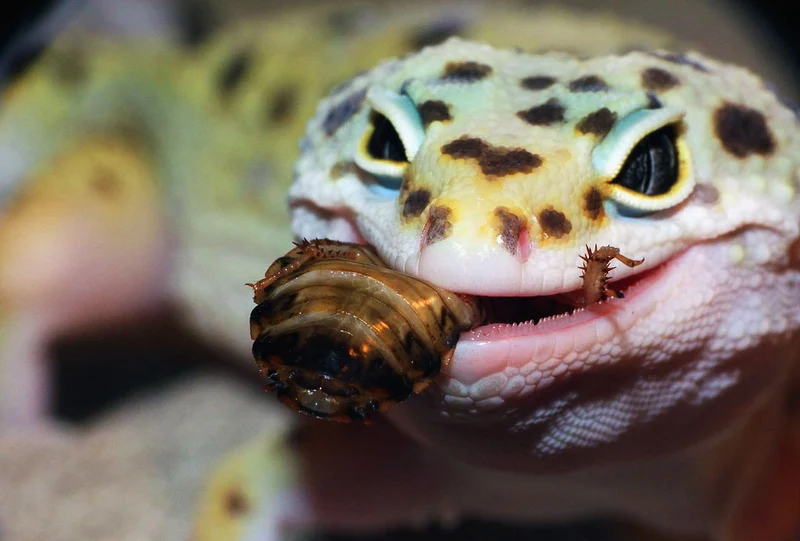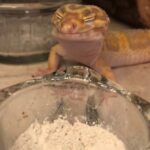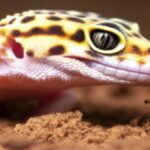Dubia roaches (Blaptica dubia), often simply called “Dubias,” are an excellent food source for Leopard geckos. These roaches are packed with balanced nutrients and are easier to breed and maintain compared to other feeder insects. Let’s dive into why Dubia roaches are preferred for Leopard geckos, how to prepare them, and the benefits they bring to your pet’s diet.
Table of Contents
Why Choose Dubia Roaches for Leopard Geckos?
Dubia roaches are nutritionally complete and highly convenient for Leopard gecko owners. These insects are high in protein, low in fat, and contain essential minerals and vitamins. Compared to crickets, Dubias are odorless and don’t make noise, making them a more manageable feeder option.
Key Benefits of Dubia Roaches:
| Feature | Benefits to Leopard Gecko Owner |
|---|---|
| Odorless | No strong smell like crickets |
| Quiet | Silent, no chirping sounds |
| Slow-moving | Easy for Leopard geckos to catch and eat |
| Non-climbing | Won’t escape cages easily |
| Nutritious | High in protein, essential for growth and health |
| Breeds Easily | Convenient for home breeding, reducing pet food costs |
Nutritional Profile of Dubia Roaches
Dubia roaches offer a balanced nutrient profile that supports the health and growth of Leopard geckos. To give you a clearer view, here’s a breakdown of the primary nutrients found in Dubia roaches compared to other common feeders.
Nutritional Comparison of Common Feeder Insects (Per 100g)
| Nutrient | Dubia Roaches | Crickets | Mealworms |
|---|---|---|---|
| Protein | 21% | 17% | 20% |
| Fat | 7% | 6% | 13% |
| Calcium | 700 mg | 300 mg | 130 mg |
| Phosphorus | 260 mg | 200 mg | 160 mg |
| Moisture | 65% | 72% | 62% |
Key Takeaways:
- Dubia roaches have a high protein content, essential for muscle growth.
- They contain more calcium than crickets and mealworms, supporting bone health.
- Dubias have a lower fat content than mealworms, reducing the risk of obesity in Leopard geckos.
Tip: To ensure optimal nutrition, gut-load Dubia roaches 24-48 hours before feeding them to your Leopard gecko. This process enriches them with additional vitamins and minerals.
How to Gut-Load Dubia Roaches for Leopard Geckos?
Gut-loading is a technique where feeder insects are given nutrient-dense foods before being fed to your pet. This process enriches the Dubia roaches, boosting their nutritional value and ensuring your Leopard gecko receives a balanced diet.
Gut-Loading Process:
- Prepare Nutrient-Rich Foods: Use leafy greens, carrots, squash, and commercial gut-loading formulas. Avoid high-water foods like lettuce, which add little nutritional value.
- Feed Dubia Roaches: Give these foods to Dubia roaches 24-48 hours before feeding them to your Leopard gecko.
- Hydrate: Provide moisture using a piece of damp sponge or vegetable slices to keep roaches hydrated.
Sample Gut-Loading Foods Table
| Food for Gut-Loading | Nutritional Benefits |
|---|---|
| Carrots | High in vitamin A, promotes eye health |
| Squash | Source of vitamin C and antioxidants |
| Kale | Rich in calcium, supports bone health |
| Sweet Potato | Contains beta-carotene for immune support |
Choosing the Right Size Dubia Roaches for Leopard Geckos
Dubia roaches come in various sizes, which makes it easy to cater to Leopard geckos of all ages. Selecting the right size is crucial for safe feeding and digestion.
Size Guide for Feeding Dubia Roaches
| Leopard Gecko Age | Recommended Roach Size |
|---|---|
| Hatchling | Small nymphs (3-6 mm) |
| Juvenile | Medium roaches (8-12 mm) |
| Adult | Larger roaches (up to 3.8 cm) |
Note: Feed Leopard geckos with roaches that are no larger than the width of the gecko’s head to avoid choking hazards.
Feeding Frequency and Quantity
Leopard geckos’ feeding requirements vary by age and size. Juveniles need more frequent feedings due to their growth rate, while adults require fewer feedings.
Feeding Schedule and Quantity
| Gecko Age | Frequency | Quantity per Feeding |
|---|---|---|
| Hatchling | Daily | 3-5 small roaches |
| Juvenile | Every other day | 5-10 medium roaches |
| Adult | 2-3 times per week | 5-8 large roaches |
Tip: Monitor your gecko’s body weight and adjust feeding amounts as needed to prevent obesity.
Health Benefits of Feeding Dubia Roaches
Feeding Dubia roaches to Leopard geckos has several health benefits. Their high protein content supports muscle growth, while the calcium promotes strong bones. The lower fat content helps to prevent weight issues in Leopard geckos, making Dubias a preferred choice over higher-fat options like mealworms.
Top Health Benefits of Dubia Roaches for Leopard Geckos
- Muscle Development: High protein levels support muscle growth and recovery.
- Bone Health: Rich in calcium, Dubias aid in developing strong bones.
- Digestibility: Soft-bodied, making them easy for Leopard geckos to digest.
- Low Fat: Reduces the risk of obesity, promoting a healthy weight.
Nutritional Graph- Protein and Calcium Content of Feeder Insects
Here’s a visual comparison of the protein and calcium content in Dubia roaches compared to crickets and mealworms:

Graph Explanation: Dubia roaches have a higher protein and calcium content, ideal for growing Leopard geckos.
Why Dubia Roaches Are Better Than Other Feeder Insects
Dubia roaches outperform many other feeder insects, such as crickets and mealworms, in both nutrition and practicality.
- No Noise or Odor: Unlike crickets, Dubias are quiet and odorless.
- Better Digestibility: Softer bodies make them easier to digest than mealworms.
- Lower Maintenance: Easier to breed and handle without risk of escaping.
Comparison Table: Dubia Roaches vs. Other Feeders
| Feature | Dubia Roaches | Crickets | Mealworms |
|---|---|---|---|
| Noise Level | Silent | Loud | Silent |
| Odor | None | Strong | Minimal |
| Digestibility | High | Moderate | Moderate |
| Breeding | Easy | Moderate | Difficult |
Final Tips for Feeding Dubia Roaches to Leopard Geckos
- Gut-load roaches before feeding to enhance nutritional value.
- Select appropriate sizes based on the age of your Leopard gecko.
- Feed in moderation to prevent weight issues.
- Store roaches in a ventilated container and provide food and moisture.
By incorporating Dubia roaches into your Leopard gecko’s diet, you’re not only ensuring they receive essential nutrients but also simplifying the feeding process. Dubias are a balanced, safe, and easy-to-handle feeder insect that meets the dietary needs of Leopard geckos effectively.





